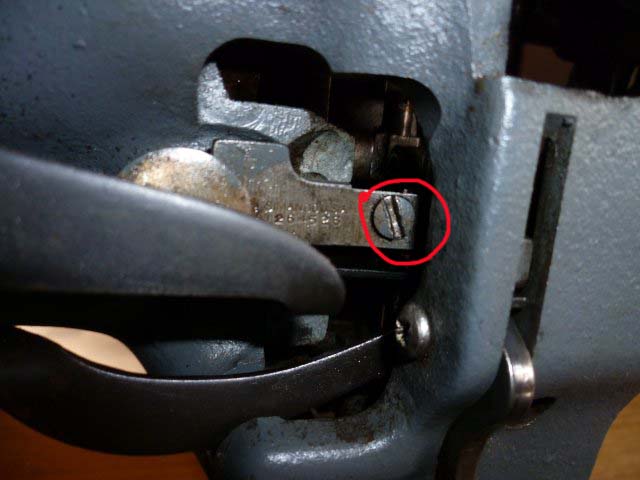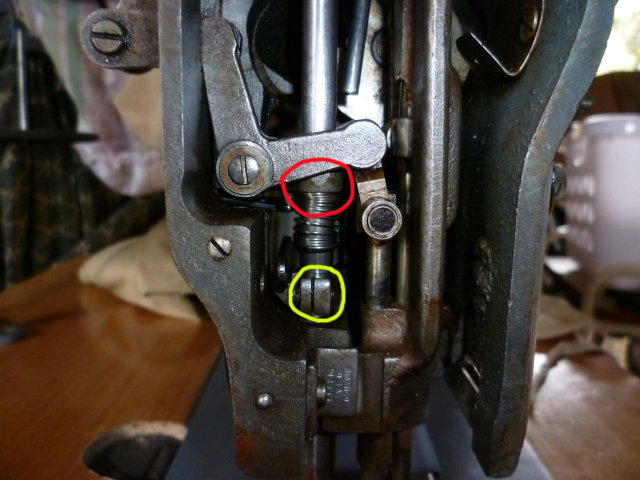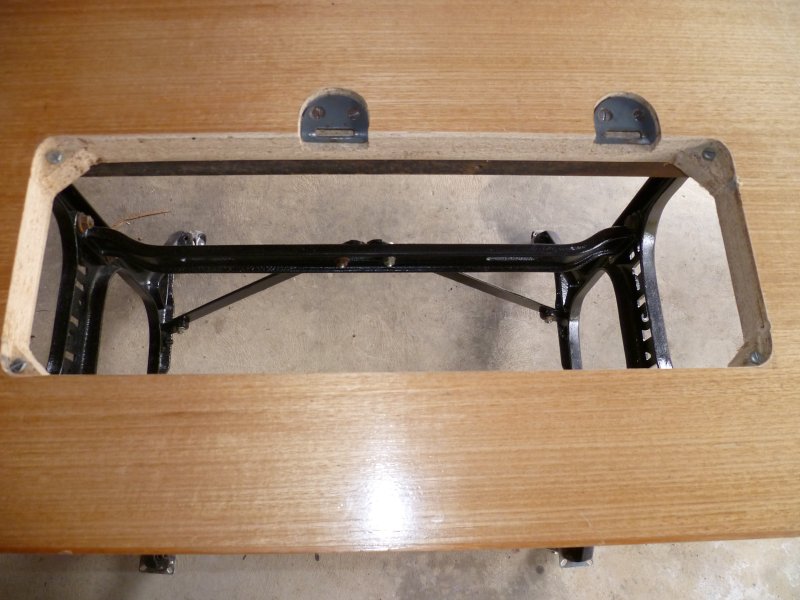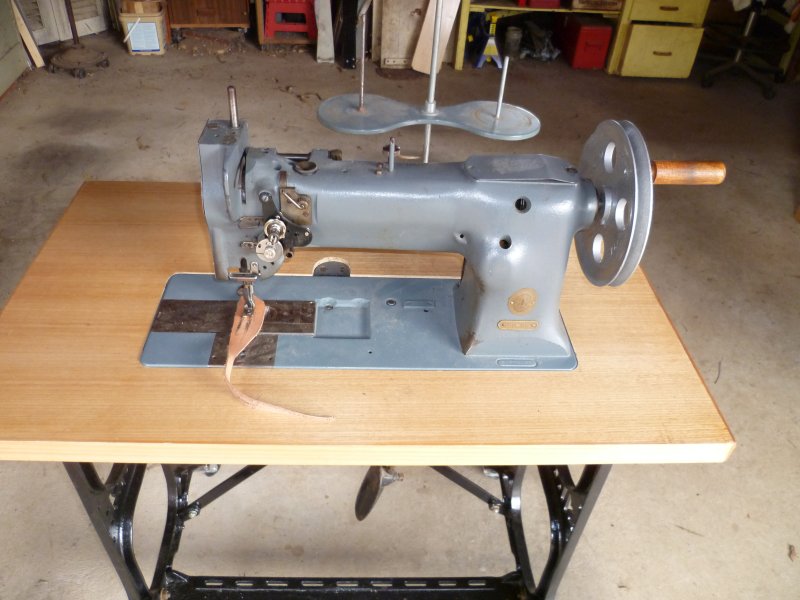-
Posts
4,554 -
Joined
-
Last visited
Content Type
Profiles
Forums
Events
Blogs
Gallery
Everything posted by dikman
-

Machine for mostly canvas, some heavier stuff
dikman replied to mwpdx86's topic in Leather Sewing Machines
That P1206RB that Wiz mentioned looks pretty good for the money, handles up to #207 thread and even includes a servo! -

Machine for mostly canvas, some heavier stuff
dikman replied to mwpdx86's topic in Leather Sewing Machines
I reckon that a flatbed should let you do pretty well all that you want. As for overkill, it's always better to get a machine that is a bit more than what you think you'll need, within reason. -

Burnishing Problem Solved - Motorized on the Cheap
dikman replied to cjartist's topic in Leather Machinery
Actually, unless you've got something completely different on your side of the pond, every grinder that I've come across has had a left-hand thread on one side and a right-hand thread on the other. It is impossible to fit the wrong spindle on the wrong side, so whichever side you use it will always tighten up (unless you some how manage to reverse the motor direction).- 21 replies
-
- burnisher
- burnishing
-
(and 1 more)
Tagged with:
-
Glad you got it sorted. The mechanics of these machines can seem a bit daunting at first, but it's worth spending the time trying to understand the operations of the particular machine that one is using. At least these older machines, for the most part, are simpler than many of the newer ones.
-

Machine for mostly canvas, some heavier stuff
dikman replied to mwpdx86's topic in Leather Sewing Machines
If you can only have one machine then a cylinder arm walking foot would be nice (the ubiquitous Pfaff 335 or clones comes to mind), but the 206RB-5 should suit nicely, particularly if you can fit a servo motor (it will give better slow speed control and be much easier to learn on than a clutch motor). As for the oiling, if you're going to be using it slowly then learn how to manually oil the various parts. It will also help you to understand the machine better. Just curious, what is the "Singer heavy duty" that you have? -
I had the same issue with my 111W117, it looks like the innards are the same. I loosened the screw at the back (photo 1) and adjusted the bar down that the presser foot is attached to (slides in collar in red, photo 2). You may need to adjust the locking collar in yellow, which the presser spring pushes on. Be aware that it is probably going to require a bit of adjusting/readjusting of these screws, in conjunction with the one you've already adjusted, to get it working right. Be careful that the crank arm (above red circle) doesn't bind on the edge of the housing where it goes through the slot. By doing this you will reduce the height under the foot a little. IF you decide to do this and you get in a mess don't blame me, you've been warned!
-
Which screw are you talking about? The screw that adjusts the rocking arm at the back is the usual way of adjusting the feet. The height of the bar holding the foot can also be adjusted from inside, but it can be a bit fiddly because, in my experience, all these adjustments tend to be interlinked.
-

Cheyenne Holsters
dikman replied to Forester's topic in Gun Holsters, Rifle Slings and Knife Sheathes
Very nice work. Did you have any problems feeding the pouch through the loops on the long barrel holster? I'm guessing you had to have it pretty wet. Firearm laws and regulations are certainly bizarre (and usually defy logic). Here in Oz replicas are treated the same as real handguns, which means you have to have a handgun licence to own a replica! -
I just had a look at his website, unfortunately it's all Greek to me! I tried enlarging the photo and it looks to be in very good condition (at least on the outside), If all he means is that the stitch length isn't as long as newer machines then it's nothing to worry about because he's right! You will probably want to factor in changing the feet/feed dog plate, as I mentioned (maybe you can beat him down a bit, based on this?) but if it sews ok then it will be a nice machine to have.
-
Figured it's time to see if this wee beastie will actually work! Foot clearance measured at 3/8", which is what I expected given that it's a 111-class machine. I shoved several layers of veg under the feet and fitted a #22 needle (no thread). It punched through ok, but tended to lift the leather on the upstroke. I couldn't get enough tension on the feet to stop it lifting. It was fine if I reduced the thickness of the leather. Changed to a #18 needle and no problems, went through whatever I could jam under the feet, with no lifting. Fitted a bobbin and some #69 thread and it sewed beautifully.Top tension was off a bit but that didn't matter. Back to the #22 needle and some #138 thread top and bottom. As long as I kept the thickness down a bit it sewed fine. I figured the 22/138 combination is probably pushing it past its design parameters, but the fact it will work if I keep the thickness down is a bonus, as far as I'm concerned. My original intention when I bought it was just to use it to pre-punch leather when handstitching, but the fact it sews is great, considering what I had to do to make it into an "ordinary" machine. Not bad for $150 .
-

Burnishing Problem Solved - Motorized on the Cheap
dikman replied to cjartist's topic in Leather Machinery
That's actually quite a clever way to mount the burnisher! It never occurred to me when I was making my burnishers - so simple that I missed it.- 21 replies
-
- burnisher
- burnishing
-
(and 1 more)
Tagged with:
-
My first thought would have been the takeup/check spring. If the stitches are coming out ok then it means you've got the tensions right, there's not much else I can think of. That spring has a couple of adjustments - travel and tension - and if either one is wrong for the thread you're using you'll probably get slack thread. I think.
-
Ah, yes, I seem to remember that coming up somewhere. I think it was the plate that the dial adjustment lever slides in, the slot was deliberately made shorter to restrict the stitch length. It doesn't make any sense that they would re-engineer the cams and offsets inside just to reduce stitch length. The machine in that photo, at least, appears to have a full-length slot. I would really like to know what the vendor meant regarding stitch length.
-
I bought mine from China via aliexpress. The company has a warehouse in Sydney so they shipped from here instead of having to come from China. I've bought three and so far haven't had any problems, however I'm aware that if something goes wrong it could be a hassle to sort out. The 550 watt (3/4 hp) were about $200 each and the 750 watt (1 hp) was $250. If you have any concerns then buying locally should give you peace-of-mind (although it will cost you more). A member on here, Darren Brosowski, sells machines and may sell just the servos (not sure).
-
G'day Lee, no, it came with a standard handwheel that the previous owner had fitted a wooden handle to (pretty rough job though). While on holiday recently, browsing through second-hand stores as one does, I saw this 8" alloy pulley for a couple of dollars. It had a bit of corrosion on part of the rim but I figured it would make a good handwheel. I cleaned it up, drilled and tapped for a handle and gave it a coat of paint - but I did have to make a bushing 'cos the centre hole was to big for the machine shaft. Once I get the feet sorted I need to find out what the limits are leather-wise that it will work with.
-
Welcome to what is probably the best leather and sewing machine information resource on the planet! For a newbie any industrial sewing machine is a big step. The Paff 335 is a very nice machine and as long as there's nothing wrong with it mechanically it should be great for what you want, and coming with a servo is a huge bonus for someone just starting out, but ideally you need to see it sewing first. Is this photo the actual machine? If so it is set up with a binding attachment (most of these seem to come that way). You can sew normally using the binding feet, but it's not ideal. The feet and feed dog plate will need to be changed to more conventional types.There have been posts about this before. Be aware that if there's anything wrong with it Pfaff parts can be somewhat expensive. I'm not sure what the vendor means by trouble with stitch length, like all machines they have a maximum stitch length, I'd want to see it sewing different stitch lengths to make sure that the stitch length adjustment is actually working ok. I haven't used mine much (too many machines!!) but I'm impressed with it's quality, and like Gary have got it to sew with #138 thread.
-
Unfortunately, Brian, living in Oz as we do, when it comes to repairing old machines the only two options we sometimes have are the first two. Good luck with your search, though.
-
You nearly got it right, Chayse - the All Blacks are Kiwis (NZ). The list so far - Had a homemade thread tension and release - replaced with a proper assembly and internal release fitting. Both feet needed adjusting to get the correct clearance Needle bar had to be adjusted to take 135x17 needles (first needle I tried went Twang! when the hook caught it). I've no idea what it was set for. Feed dog was set too high Came fitted with 1/4" piping feet (nearly all my machines came with these , most peculiar). For some reason the vibrating feet off my 111/211 don't line up on this machine so because these feet fit I've decided to fill the piping grooves with epoxy and sand flat to give me usable feet. Chayse, the routing itself wasn't difficult. Rather than make a template to use as a guide, I clamped a guide along one edge of the table , with stops so I didn't go too far, and took 3 or 4 passes, going deeper each time until I went through. I then shifted the guides to the next edge. It was a bit time consuming, but I'm pleased with the cutout itself. Where I went wrong with the corners is that I should have taken shallow cuts and checked as I went, instead I relied on my measurements and tried to do it in one go. Dumb!
-
Uwe, your photo enlargement showing the thread path makes me wonder how it worked at all.
-
No cold one yet, Chayse. As it's Winter I'm having a nice hot cup of tea instead! The feet height still have to be adjusted and when I put a needle in it hit the hook, so some tweaking is going to be needed there, but that's all fun stuff compared to building the table.
-
I finally got around to making a table for the 117, because it has a longer baseplate than the "normal" Singers I couldn't just swap it out with an existing one. I had an old cast Singer industrial base and used a spare ordinary tabletop I had that I cut down to fit.I carefully measured and routed out the hole, but when it came to routing the depth of the corner supports even though I carefully measured and double checked I still cut them too deep!! Oh well, I figured I'd build it up with hard rubber later. The hinge cutouts were an absolute pain, I thought I had them right but they were too high so it was matter of cut a bit, drop in the machine, lift it out, cut a bit more etc. etc. Lifting that lump in and out all the time hasn't done my back any good! Finally got it right but boy, they're deep. As for the corners, it occurred to me that if I used wood screws in the corners I should be able to adjust them to get the correct height. It actually worked! Due to the weight of this lump, and the fact that the table is chipboard, I fitted a piece of angle iron underneath the middle, resting on the top of the legs and screwed to the table to add some stiffening and support.As it is going to live in my garage I need to be able to move it around. Fitting wheels was a problem, as everything I came up with was either very complicated or lifted the table too high - so I took the simple approach and tack-welded casters onto the bottom of the legs. My intention is to keep this as a hand-operated machine, but if I should decide to motorize it I'll just stick the motor on the top of the table behind the head (as Uwe has done before). Oh, and fitting the knee lift was another pain-in-the-butt, took me about three hours to get it sorted!!!!!!
-
Why does the thread appear to be wrapped around the thread tension nut?
-
bb, my advice is do not consider importing direct from China. It's the sort of thing I would do, but then I like a challenge and I'm known for knocking my head against a brick wall! If 1) you are mechanically adept and like fiddling with things 2) are prepared to spend time learning about the mechanics of these machines and 3) are happy to spend time chasing spare parts then by all means look for an older machine. If you can afford it, and as you obviously have little experience with industrial machines, your best bet however is to buy from one of the sponsors here. They have demonstrated that they will look after a customer and you will have peace-of-mind that your machine will work (and more importantly keep working). You may occasionally have to tweak it a little, but that's a lot easier than trying to get a worn machine to stitch consistently! Plus you will be getting a machine that is suitable for what you want to make.
-
There have been a few manufacturers who have copied the Pfaff 335 design. If you look for cylinder arm machines on various manufacturers' websites and find one with 335 somewhere in the description it's a safe bet that it's a 335 clone. I don't know what brands you have access to over there but look at their websites.
-
NIce (as usual). Interesting ideas, sewing the holsters along the front and back edges, and sewing the cartridge loops onto a leather strap first and then sewing that to the belt is neat. I've been putting off making a cartridge belt as I just couldn't come up with a design that appealed to me, but your idea has possibilities.






